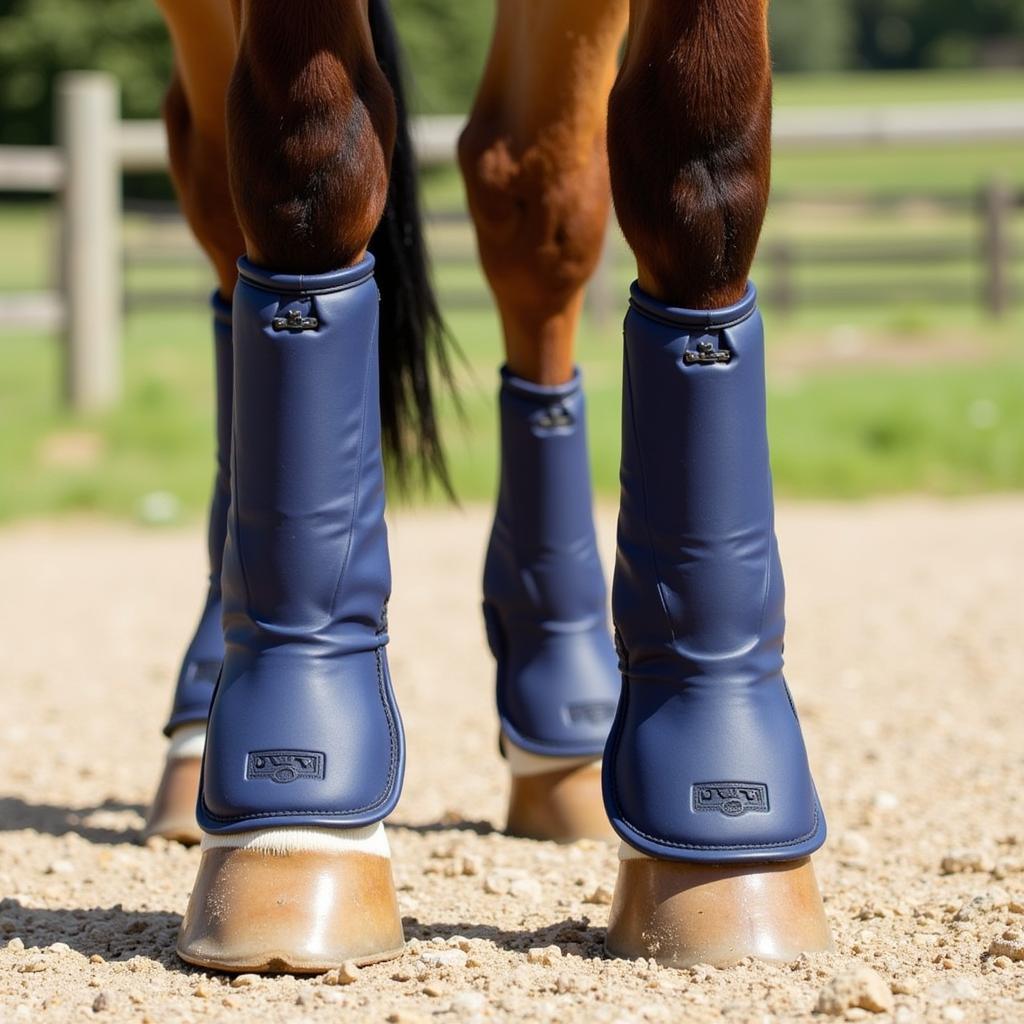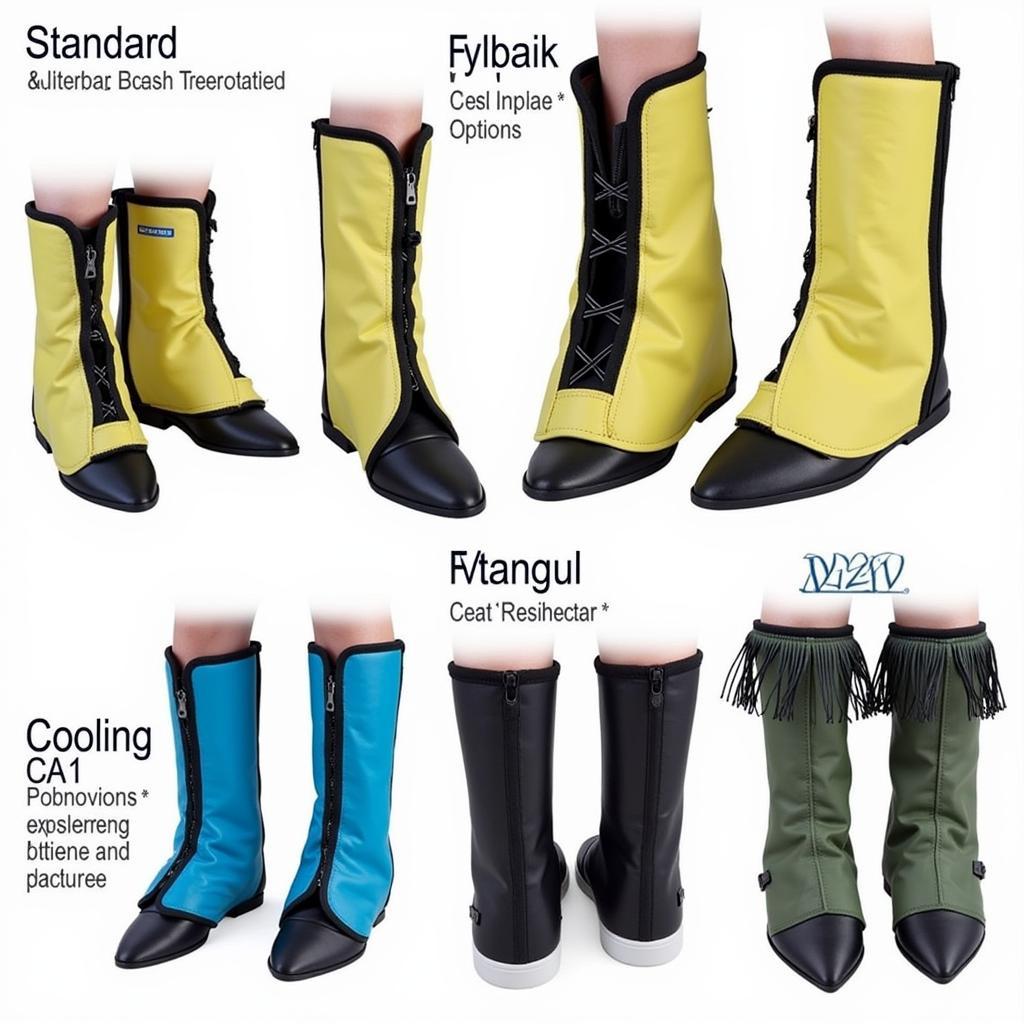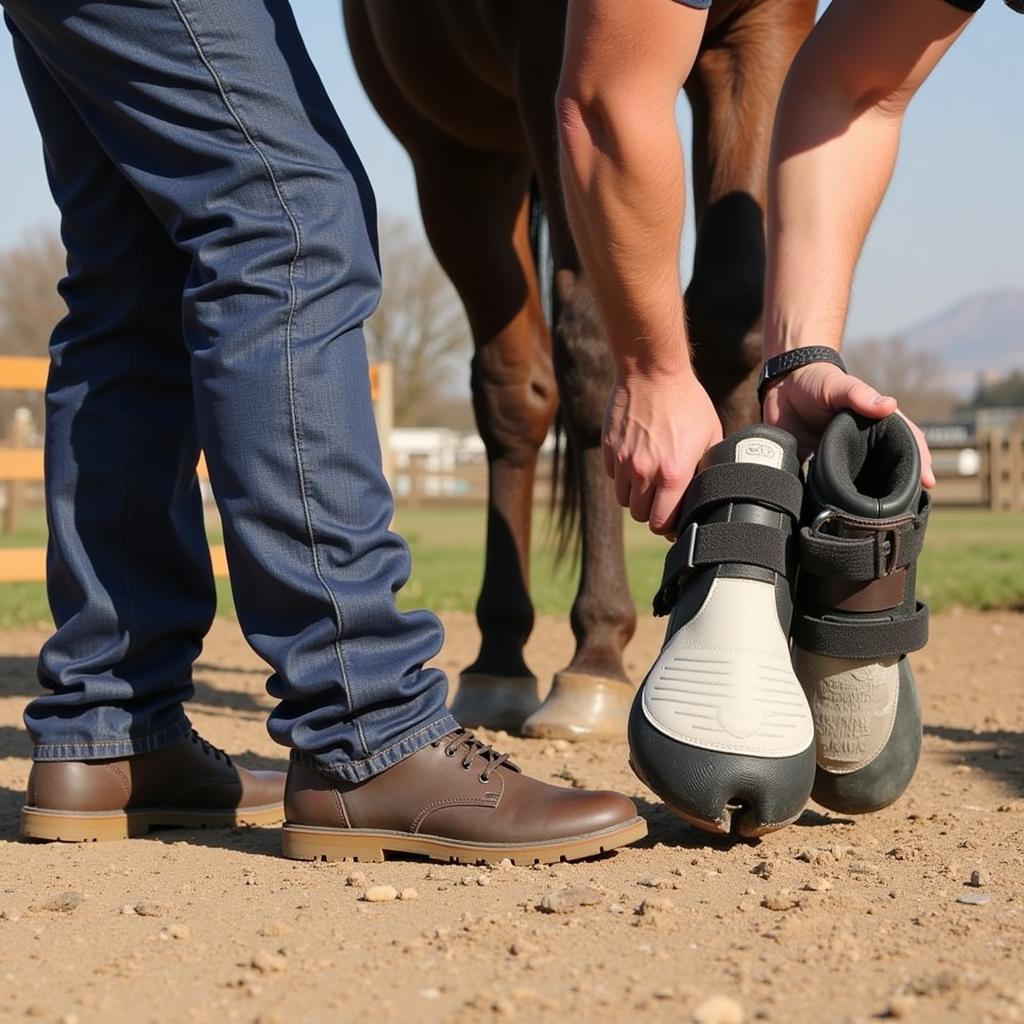Fly boots, a common sight in equestrian disciplines, are an essential piece of equipment designed to protect your horse’s legs from pesky flies and other biting insects. Not only do they offer relief from irritating bites, but they also provide valuable protection from potential injuries during riding and turnout.
Understanding the Importance of Fly Boots for Horses
Horses are particularly susceptible to fly bites on their legs for several reasons. Firstly, their lower legs lack the thick hair coat found on their body, making them vulnerable to biting insects. Secondly, flies are attracted to moisture, and a horse’s lower legs often sweat, especially during exercise or warm weather. This creates a prime target for flies seeking a blood meal.
Continual fly bites can lead to a range of problems for your equine companion. The constant irritation and itching can cause horses to stomp their feet excessively, leading to fatigue and stress. In some cases, horses may develop allergic reactions to fly bites, resulting in painful welts and sores. Furthermore, open sores from scratching can become infected, posing a serious health risk.
 Horse Wearing Fly Boots
Horse Wearing Fly Boots
Types of Fly Boots for Horses
When it comes to fly boots, there is no one-size-fits-all solution. Different types of fly boots cater to specific needs and preferences. Let’s delve into the most common types:
1. Standard Fly Boots
As the name suggests, standard fly boots are the most basic type, offering general protection against flies and other insects. They typically cover the horse’s legs from below the knee to the pastern or coronary band. Made from durable materials like mesh or neoprene, they effectively prevent insects from reaching the skin while allowing for breathability.
2. UV-Protective Fly Boots
For horses with sensitive skin or those spending prolonged periods outdoors, UV-protective fly boots are a game-changer. These boots are designed with special fabrics that block harmful ultraviolet (UV) rays, protecting the horse’s skin from sunburn and potential long-term damage.
3. Cooling Fly Boots
During hot weather, keeping your horse comfortable is paramount. Cooling fly boots often feature breathable mesh panels and moisture-wicking materials to regulate temperature and prevent overheating. Some varieties even incorporate cooling gels or inserts that can be chilled before use, providing additional relief from the heat.
4. Fly Boots with Fringe
For horses that are particularly bothered by flies around their faces and ears, fly boots with fringe offer a unique solution. The added fringe hangs down from the boot, acting as a deterrent by brushing away flies before they can land and bite.
 Variety of Fly Boots for Horses
Variety of Fly Boots for Horses
Choosing the Right Fly Boots for Your Horse
Selecting the appropriate fly boots for your horse depends on several factors, including climate, riding discipline, and individual needs. Consider these aspects when making your choice:
- Climate: Opt for breathable mesh boots in hot, humid climates, while waterproof or water-resistant options are suitable for wet conditions.
- Riding Discipline: Choose boots that offer adequate protection without interfering with your chosen riding style. For instance, dressage riders might prioritize sleek, close-fitting boots, while those participating in jumping may prefer boots with added impact protection.
- Individual Needs: Consider your horse’s specific requirements, such as sensitivity to UV rays, allergies, or previous injuries, when selecting fly boots.
Fitting Fly Boots Correctly
Proper fit is essential to ensure the efficacy and comfort of fly boots. Ill-fitting boots can rub, slip, or restrict movement, leading to discomfort and potential injuries.
- Measure Accurately: Consult the manufacturer’s size chart and measure your horse’s legs carefully to determine the correct size.
- Check for Snug Fit: The boots should fit snugly without being too tight. You should be able to comfortably slip two fingers between the boot and your horse’s leg.
- Inspect Regularly: After each use, check the boots for any signs of wear and tear, such as loose seams, tears, or missing Velcro closures. Replace damaged boots promptly.
Maintaining Fly Boots for Optimal Performance
Proper care and maintenance can extend the lifespan of your fly boots, ensuring they continue to provide optimal protection.
- Regular Cleaning: After each use, remove any dirt, debris, or hair from the boots. Most fly boots can be washed with mild detergent and water.
- Thorough Drying: Allow the boots to air dry completely before storing them in a cool, dry place. Avoid exposing them to direct sunlight or heat sources.
- Inspect for Damage: Regularly check for signs of wear and tear, repairing or replacing damaged boots as needed.
 Cleaning Horse Fly Boots
Cleaning Horse Fly Boots
Beyond Fly Protection: Additional Benefits of Fly Boots
While fly protection is their primary function, fly boots offer additional benefits that contribute to your horse’s overall well-being.
- Leg Support: Certain types of fly boots provide mild compression and support to the tendons and ligaments in the lower legs, which can be beneficial during exercise or for horses recovering from injuries.
- Protection from UV Rays: UV-protective fly boots safeguard the delicate skin on your horse’s legs from harmful sun exposure, reducing the risk of sunburn and long-term skin damage.
- Injury Prevention: During turnout or riding, fly boots can help prevent minor injuries from scrapes, abrasions, or knocks.
Conclusion
Fly boots are an indispensable part of equine care, providing essential protection from irritating insects and contributing to your horse’s comfort and well-being. By understanding the different types, choosing the right fit, and implementing proper care, you can ensure your equine companion enjoys the many benefits of these valuable protective gears. Remember, investing in high-quality fly boots is an investment in your horse’s health and happiness.
FAQs about Fly Boots for Horses
Do horses need to wear fly boots all the time?
While not necessary 24/7, fly boots are most beneficial during peak fly season or when horses are outdoors for extended periods.
Can fly boots be used on horses with sensitive skin?
Yes, many fly boots are designed with soft, breathable materials suitable for sensitive skin. Look for hypoallergenic options or those specifically labeled for sensitive skin.
How do I prevent fly boots from rubbing my horse’s legs?
Ensuring proper fit is crucial. If rubbing occurs, consider using a boot liner or applying a thin layer of petroleum jelly to the areas prone to irritation.
Can fly boots be used in conjunction with other leg protection?
Yes, fly boots can be worn with other types of leg protection, such as splint boots or polos, depending on the specific needs of the horse and the riding discipline.
What is the average lifespan of a pair of fly boots?
The lifespan varies depending on usage, care, and quality. With proper maintenance, high-quality fly boots can last for several seasons.
For all your horse gear needs, including a wide selection of fly boots, visit our horses gear collection. We offer a variety of options to suit every horse and budget. Looking for stylish and functional attire for yourself? Explore our dress up for horses collection, featuring the latest equestrian fashion. Don’t forget to check out our homemade fly spray for horses recipe for a natural way to deter pesky insects. If you’re into barrel racing, our selection of barrel racing boots for horses will meet your needs. For top-quality equestrian equipment, browse our range of Lemieux horse tack.
Contact us at Phone Number: 0772127271, Email: [email protected], or visit us at QGM2+WX2, Vị Trung, Vị Thuỷ, Hậu Giang, Việt Nam. Our dedicated customer support team is available 24/7 to assist you.